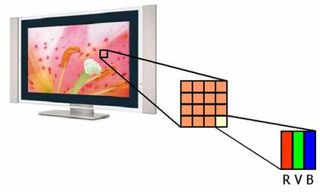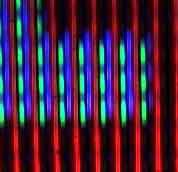LCD Or Plasma - What's Your Pleasure? Understanding Modern Flat-Panel TV Technologies
Display Basics
If you're already familiar with display technologies, you can go directly to the next section. This paragraph will give you an overview of the basic technologies manufacturers use to show different colors on CRT, plasma and LCD displays.
The general approach manufacturers have taken from the start to display the full spectrum of colors has been to break them down. Rather than designing complex pixels capable of displaying a multitude of shades, each pixel is made up of three sub-pixels, each displaying one of the primary colors: red, green, or blue.

When the user is located at a certain distance from the screen, he or she is no longer able to resolve each subpixel, but only the mixture of the three. This makes it possible to reproduce an entire palette of colors from various mixtures of red, green, and blue. All shades of gray can also be generated, from absolute black to bright white, by using all three primary colors in equal amounts.

Considering red, green, and blue to be primary colors might come as a shock to those who know something about painting, for whom the primary colors are red, yellow, and blue. What we're talking about here are additive primary colors, and according to the additive color model, red, green, and (RGB) are the primary colors.
Here's an example of implementation of the model on a cathode ray tube (CRT):

You can see the separate sub-pixels in each primary color.
All modern display technologies - CRT, LCD, and plasma - are based on this principle. In the following sections, we'll see how each technology approaches the problem.
Stay on the Cutting Edge
Join the experts who read Tom's Hardware for the inside track on enthusiast PC tech news — and have for over 25 years. We'll send breaking news and in-depth reviews of CPUs, GPUs, AI, maker hardware and more straight to your inbox.

Ryzen 9 7950X3D surfaces with 192MB L3 cache, 64MB more than retail CPU — may be an ES CPU or software detection error

Multi-million dollar Cheyenne supercomputer auction ends with $480,085 bid — buyer walked away with 8,064 Intel Xeon Broadwell CPUs, 313TB DDR4-2400 ECC RAM, and some water leaks

Mod turns ROG Ally into a modern-day Nintendo DS — the second screen also serves as a stand for the gaming handheld
Most Popular


